I’ve tackled my share of sticky disasters—from peeling off old bumper stickers to scrubbing crayon scribbles off the fridge—and nothing frustrates me more than a residue that just won’t budge.
In this article, I break down Goo Gone and Goof Off, two go-to cleaners that promise to wipe out adhesives without turning your project into a bigger headache.
Whether you’re dealing with light tape gunk or industrial-grade glue, I’ll walk you through their strengths, weaknesses, and when to grab one over the other, so you can choose wisely and get back to your day.
| Feature | Goo Gone | Goof Off |
| Base Formula | Citrus-based, milder solvents | Acetone-based, heavy-duty solvents |
| Best For | Everyday stickers, tape, gum on delicate surfaces | Tough tar, paint, super glue on hard surfaces |
| Surface Safety | High—safe on paint, plastic, fabric | Moderate—risks damage to plastics, some paints |
| Scent | Pleasant orange citrus | Strong chemical odor |
| Application Ease | Spray or liquid, quick wipe-off | Concentrated spray, needs careful testing |
| Residue After Use | Oily film (easy soap cleanup) | Minimal, but test for etching |
| Price per Ounce | Around $1.50 (8 oz bottle) | Around $2 (4 oz bottle, more potent) |
| Eco/Safety Rating | Better for home use, less harsh fumes | Industrial strength, requires ventilation |
| User Verdict | Wins for family-friendly jobs | Edges out on brute-force cleanups |
What Makes Goo Gone My Go-To for Quick Fixes
When I first popped open a bottle of Goo Gone, it felt like uncovering a secret weapon for life’s little messes. Whether it’s a sticker clinging to a new dish or gum mashed into a carpet, this citrus-powered cleaner has become my reflex pick for quick, no-drama solutions.
Here’s why it’s earned a permanent spot in my cleaning arsenal.
- Citrus Power That Cuts Through Without the Fight
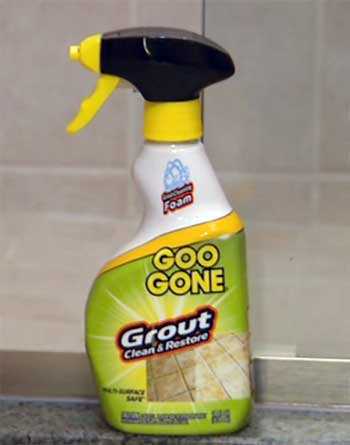
Goo Gone’s magic lies in its citrus-based formula, blending orange oil with petroleum distillates to dissolve adhesives gently.
I remember a frantic evening peeling price tags off a dozen thrift store wine glasses for a dinner party.
A quick dab of Goo Gone, a 30-second wait, and each label slid off like butter, leaving the glass sparkling.
No scratches, no haze—just clean surfaces.
It’s a lifesaver on delicate materials like painted wood or plastic containers, where aggressive chemicals might leave a mark.
The citrus oils soften the adhesive bond, making it ideal for jobs where you need precision without punishment.
- Versatile for Home and Car Chaos
What I love most is how Goo Gone handles a laundry list of household headaches. Kids doodled crayon on your dining room wall? I’ve been there—swiped it away in minutes without fading the paint. Gum stuck to a shoe from a parking lot mishap?
A drop of Goo Gone softened it enough to scrape off with a plastic knife. I’ve even used it to rescue my car’s dashboard from double-sided tape residue after a phone mount experiment gone wrong. It’s safe on upholstery, too—one time, I tackled glitter glue on a couch cushion, and the fabric stayed pristine, smelling faintly of oranges instead of a chemical lab.
- No-Fuss Application That Saves Time
The application is dead simple, which is a godsend when you’re juggling a busy day. The spray bottle lets you target small spots, while the liquid version works for soaking bigger areas. I keep a bottle in my garage for quick hits on tools or paint cans with stubborn labels.
Spray, wait a minute, wipe, and done—no need for heavy scrubbing or multiple passes. Once, I cleared a sticky residue from a toolbox in under five minutes, turning a tedious chore into a quick win. That ease makes it my default for anything from kitchen counters to kids’ toys.
- Unexpected Uses That Shine
Beyond the obvious, Goo Gone surprises with its range. I’ve used it to lift permanent marker from a whiteboard when dry-erase cleaner failed. It’s also great for degreasing kitchen appliances—think stovetop splatters or grease on cabinet handles.
One quirky win: I cleaned sap off my dog’s fur after a hike, and it worked without irritating her skin. It’s like having a Swiss Army knife for sticky situations, versatile enough to keep around for whatever mess life throws.
The Downsides of Goo Gone That Keep Me on My Toes
Don’t get me wrong; Goo Gone isn’t flawless. I’ve learned the hard way that its gentleness has limits, especially when you’re short on patience.
- Oily Leftover That Demands Extra Steps
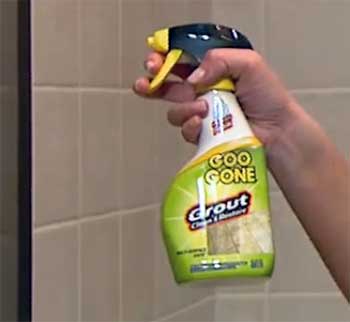
Every time I use it, there’s this slight greasy film left behind, like the citrus oils are saying goodbye with a hug.
On metal surfaces, it’s no big deal—just a quick rinse with dish soap fixes it.
But on fabrics?
I’ve had to run loads through the wash to fully banish the sheen.
Once, after cleaning sticker goo from a leather couch, I spent another 10 minutes buffing with a dry cloth to avoid any shine mismatch.
- Struggles with the Toughest Gunk
For lighter duties, it’s a champ, but throw super glue or road tar at it, and it starts to falter. I once tried it on a workbench splattered with epoxy drips—after two applications, I still had to scrape manually. It’s like asking a butter knife to cut steak; it nicks the surface but doesn’t go deep.
If your mess is more “construction site” than “craft fail,” this might leave you reaching for reinforcements.
- Cost Adds Up for Frequent Users
At about $12 for an 8-ounce bottle, it’s affordable for occasional use, but if you’re like me and hit adhesives weekly, the tabs climb. Plus, the citrus scent, while nice, can linger in enclosed spaces, turning your laundry room into a perpetual orange grove. Not ideal if scents trigger headaches.
Also Read: Comparison of Kaboom And OxiClean.
Why Goof Off Packs A Punch For Heavy Hitters?
When Goo Gone hits its limit, I reach for Goof Off—the brute force of adhesive removers. This stuff is my ace for the messes that make other cleaners flinch, and it’s saved me from some serious headaches.
- Aggressive Solvents That Blast Away Stubborn Buildup
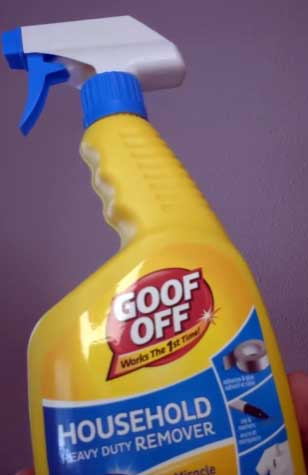
Goof Off’s acetone and xylene blend is like a sledgehammer for adhesives.
I once faced dried latex paint splattered on my garage’s concrete floor from a sloppy reno.
A few sprays, a minute’s wait, and it dissolved into a smear I could wipe away—no scraper needed.
It’s my go-to for tar on driveways, super glue on metal tools, or even graffiti tags on outdoor furniture.
The solvents break molecular bonds fast, making it ideal for messes that laugh at milder formulas.
- Built for Tough Surfaces and Pro Tasks
This cleaner thrives on hard, non-porous surfaces like metal, glass, or ceramic tile. I’ve used it to strip wax from antique candlesticks, leaving them gleaming without a trace of residue. In my workshop, it’s cleared ink stains from a workbench and adhesive from old hardware in seconds.
For automotive jobs, it’s a beast—think overspray on a bumper or sap on a nums. I tested it on my truck’s chrome trim, and it cleaned without dulling the shine, though I waxed afterward to be safe.
- Fast-Acting Formula for When Time’s Ticking
Goof Off works lightning-fast, which is clutch when you’re on a deadline. I used it to strip dealer badges off a rental car before returning it—spray, wait, wipe, and done in under two minutes. The concentrated spray hits exactly where you aim, and the formula evaporates quickly, leaving no drippy mess.
That speed saved me during a last-minute cleanup of tar spots on a trailer hitch before a road trip. It’s built for pros or DIYers who need results now, not later.
- Industrial Edge for Specialized Jobs
Goof Off’s strength makes it a niche star. I’ve used it to remove dried caulk from bathroom tiles, saving hours of scraping. It’s also great for stripping old sealant from boat hulls or cleaning grease from engine parts.
Once, I tackled a rusted bolt covered in adhesive residue—it cut through the gunk, letting me free the bolt without damaging the threads. For jobs requiring precision and power, it’s unmatched.
Goof Off’s Rough Edges That Demand Respect
Goof Off’s power comes with caveats; I’ve got the battle scars to prove it. It’s not a spray-and-forget deal.
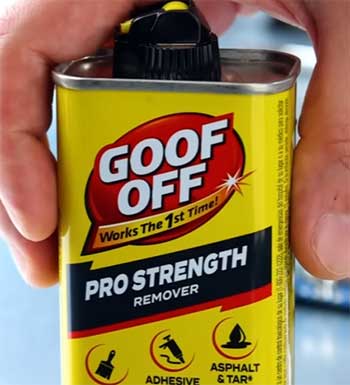
- Risk of Surface Damage on Delicates: Here’s where it bites: plastics and painted finishes. I once misjudged and hit a plastic toy bin— it fogged the surface like a bad etch job. On car paint, it can dull clear coats if left sitting, forcing a polish session afterward. Always spot-test, or you’ll spend more time fixing than cleaning.
- Harsh Fumes and Safety Hurdles: The chemical whiff hits hard—think nail polish remover amplified. Working in my basement, I had to crack windows wide or risk a headache. Gloves are non-negotiable; it dries skin like sandpaper. And with ingredients linked to irritation, it’s not for kids’ rooms or prolonged exposure.
- Smaller Size Means More Frequent Buys: That potent 4-ounce bottle runs $8-10, but it vanishes faster on big jobs. For a full fence cleanup, I burned through two cans, outpacing Goo Gone’s value. Plus, the aggression sometimes overdoes it, etching grout if you’re not vigilant.
Also Read: Comparison of Scrub Daddy And Magic Eraser.
Head-to-Head Comparison of Goo Gone And Goof Off In Real Scenarios
I’ve put both through the wringer on real projects, so let’s see how they stack up when the mess hits the fan. These are my unfiltered takes from battles won and lost.
- Sticker and Tape Removal Showdown
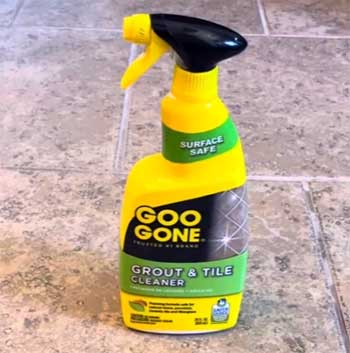
For glass jars from a thrift store spree, Goo Gone was the MVP.
A quick spritz softened labels in 30 seconds, letting me peel them off without a trace—no haze, no scratches.
Goof Off was overkill; it worked but left me coughing from the fumes in my small kitchen.
On outdoor duct tape stuck to a metal signpost, though, Goof Off shredded the residue in one pass, while Goo Gone needed three applications and still left bits behind.
For delicate surfaces, Goo Gone’s your friend; for weathered, stubborn tape, Goof Off’s the hammer.
- Handling Glue and Gum Battles
Super glue on a workbench was a test of wills. Goof Off melted it in seconds, though it slightly etched the wood’s finish, forcing a light sand. Goo Gone barely dented it, and I ended up scraping with a blade.
For gum under a dining table, Goo Gone’s gentle touch preserved the varnish, letting me wipe it clean with a cloth. Goof Off would’ve risked softening the finish, so I skipped it. Light adhesives lean toward Goo Gone; industrial glues scream for Goof Off.
- Automotive Mess Cleanup Clash
Bumper stickers on my old truck? Goo Gone erased them cleanly, leaving the paint untouched—a quick wax sealed the deal. Tar spots from a highway drive were another story; Goof Off obliterated them in one go, though I buffed the area immediately to protect the clear coat.
Goo Gone smeared the tar around, leaving streaks that took extra effort to clear. For car paint, Goo Gone’s safer; for tar or sap, Goof Off’s your heavy hitter.
- Fabric and Upholstery Face-Off
Crayon on my couch cushions was a parenting nightmare. Goo Gone lifted it without fading the fabric, and a soap rinse cleared the oily film. Goof Off, when I tested it on a scrap of similar fabric, dulled the dye in patches—lesson learned.
For ink on work jeans, Goof Off cut through faster, but I had to pre-test to avoid bleaching. Goo Gone’s safer for home textiles; Goof Off’s better for rugged fabrics if you’re cautious.
- Specialty Messes: Paint, Tar, and Beyond
Dried latex paint on a concrete porch? Goof Off dissolved it in a minute, no scraping needed. Goo Gone softened it but left me chipping away. For tree sap on my kayak, Goof Off cleaned it without harming the fiberglass, while Goo Gone needed multiple passes.
Marker on a kid’s toy? Goo Gone wiped it clean without damaging the plastic; Goof Off fogged a test spot. Each has its niche—Goo Gone for precision, Goof Off for raw power.
- Overall Versatility Verdict
Goo Gone handles 80% of my household messes with kid-glove care, making it my daily driver. Goof Off tackles the 20% monsters—think construction adhesives or garage spills—but demands respect. I keep both in my garage; they’re partners, not rivals, each shining where the other stumbles.
Also Read: Is Bowl Refresh Toilet Cleaner Worth It?
Frequently Asked Questions (FAQ)
Avoid plastics, polished finishes, leather, and some automotive paints—it can etch, melt, or dull them quickly.
No, it’s an acetone-based blend with xylene and other solvents for extra power, but not pure acetone.
It depends on the job, but 3M General Purpose Adhesive Remover often tops lists for its balance of strength and surface safety.
For tougher tasks, Goof Off outperforms; for gentler options, rubbing alcohol or 3M Adhesive Remover edges it out without oily residue.
Wrapping It Up: Your Mess, Your Match
There you have it—my no-holds-barred look at Goo Gone and Goof Off, born from too many sticky Sundays in the garage and kitchen. You’ve seen how Goo Gone keeps things light and safe for your daily battles, while Goof Off brings the thunder for those rare beasts that demand respect.
Now, it’s your turn: grab the one that fits your next project, test a corner first, and reclaim your surfaces without the drama. What’s the stickiest mess you’re facing? Whichever tool you pick, you’ll wonder how you ever lived without it.
